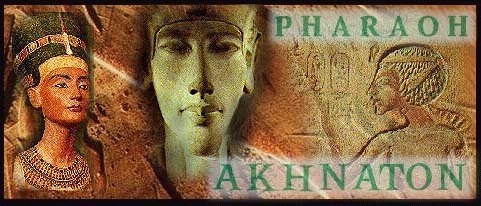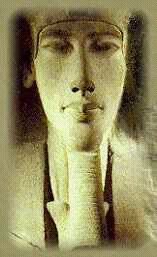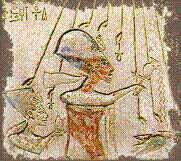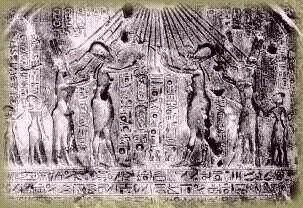
Ikhnaton the Heretic King
by Jenni Bonnet
Amonhoptep IV, also known as Ikhnaton or Akhenaton, was pharaoh between the years 1350 to 1334 BC. He was the tenth pharaoh of the 18th Dynasty. Ikhnaton died during the eighteenth year of his reign. He was the son of Amenhotep III and Tiy, and husband of Nefertiti, who was considered to be one of the ten most beautiful women in history. Ikhnaton was also father of the boy-king, Tutankhamen. Ikhnaton established a religion based on the idea of monotheism. He began the worship of Aton, the solar disk or sun god, which he believed to be the single creator of the universe. After he founded the new religion, Ikhnaton changed his name from Amenhotep IV, to Ikhnaton, meaning, "Aton is satisfied." He moved his capital from Thebes to Tell-Ell Amarna, (or Akhet-Aton, "The Place Where Aton Rises") and built a new city faithful to the worship of Aton. The new city was built halfway between Thebes and Memphis on the eastern bank of the Nile River.

Ikhnaton during his reign
Some say that Ikhnaton was one of the greatest pharaohs that ever lived, because of the fact that he changed the traditions of his predecessors. He also ordered the removal of all indications of the religion of his ancestors. He had an ongoing conflict with the priests who tried to continue the same traditional ceremonies of their parents worshipping the god Amon, or Amen. Another thing Ikhnaton changed was how he presented himself and his family in all sculptures and paintings done during his reign. He and his wife were very affectionate towards each other, in almost every painting or relief, they were touching each other in ways not seen before in Egyptian art. Also by looking at the art from Ikhnatons rule, we see that Ikhnaton was very conceited. He had himself portrayed in thousands of pictures and such, archaeologists think that he liked seeing himself so many times.

Relatives of the Pharaoh Ikhnaton
Ikhnaton had many temples and monuments built in his honor. Ikhnaton had himself drawn as he really looked, even as he was slightly deformed. His head was very long, and his abdomen was swelled. His thighs were also very swollen, and turned out a little. Some say he had himself portrayed like this because of the god he worshipped.

Mural depicting Ikhnaton worshipping Aton
The god Aton was half male, half female, so maybe Ikhnaton wanted to be half also. Others say that maybe all the inbreeding in his ancestry finally caught up with the family, and Ikhnaton still wanted to show his true looks. All the pharaohs before him had one ideal image; they were all painted the same way. Ikhnaton changed yet another tradition by refusing to conform to that custom. Ikhnaton didnít see the need to be just like everyone else. He wanted to be a pharaoh that people remembered, not forgot. Someone did try to erase any proof that he existed though. His name and any information about him were scraped off of any place they were written. But the memory lived on about Ikhnaton. He was a great pharaoh, father, husband, and leader for the Egyptians.

A wall mural made during the Amarna Period
Sources: |
Velikovsky, Immanuel. Ages in Chaos. New York: Doubleday and Company Inc., 1952 |
| Velikovsky, Immanuel. Oedipus and Akhnaton. New York: Doubleday and Company Inc., 1960 | |
| Earthlore Topical Rendering Pharaoh Akhnaton @ www.elore.com/el10tr01.html, Dec. 18, 1999 | |
| Sheppard, E. J. Ancient Egypt. London: Longman, 1960. | |
| Gordon, Lori A. "The Beautiful One Is Come." Calliope, Nov/Dec Issue, 1991: 10-14. |
Picture Credits:
Picture #1 - "Pharaoh Akhnaton" @ www.elore.com/el10tr01.html
Picture #2 - "Ikhnaton during his reign" @ www.elore.com/el10tr01.html
Picture #3 - "A wall mural made during the Amarna era" @ www.elore.com/el10tr01.html
Picture #4 - "A mural depicting Ikhnaton worshipping Aton" @ www.elore.com/el10tr01.html
Picture #5 - "Relatives of Pharaoh Ikhnaton" @ www.elore.com/el10tr01.html